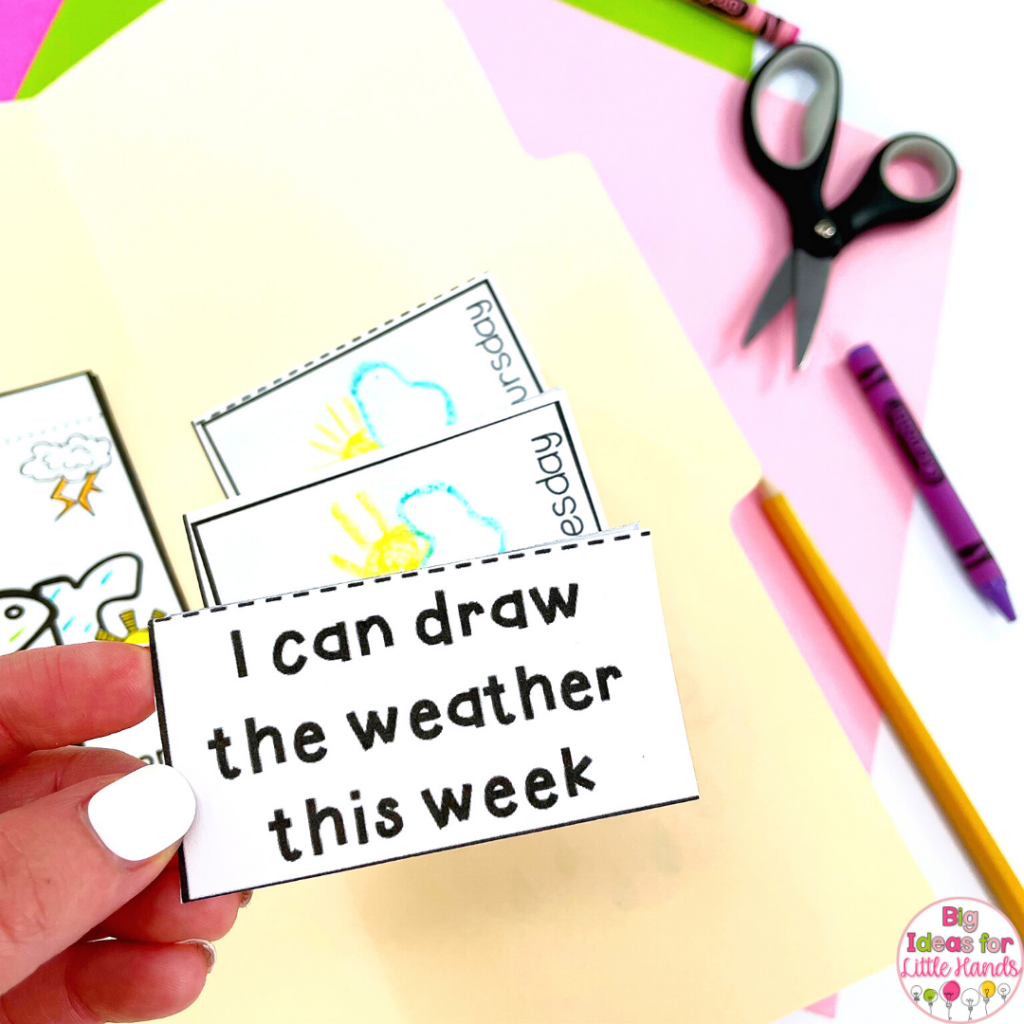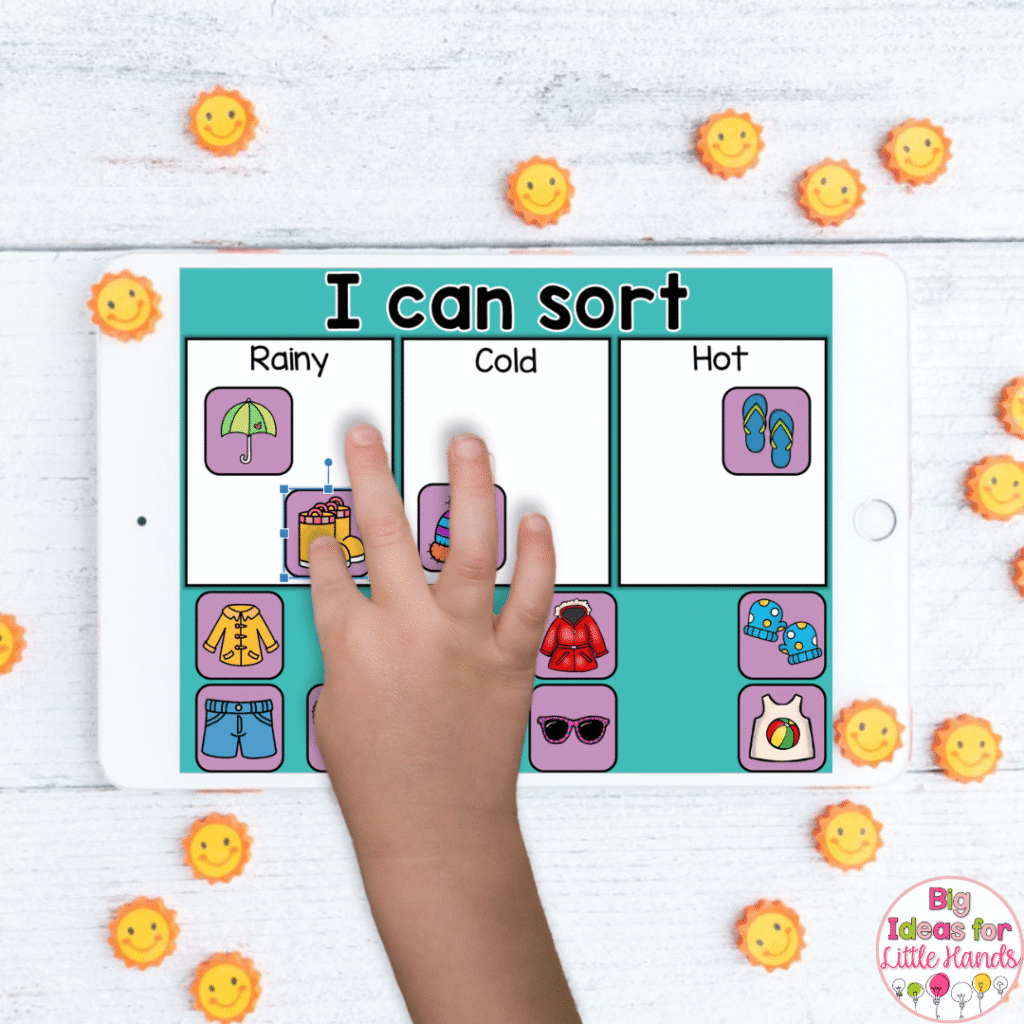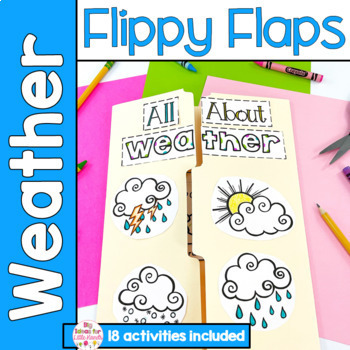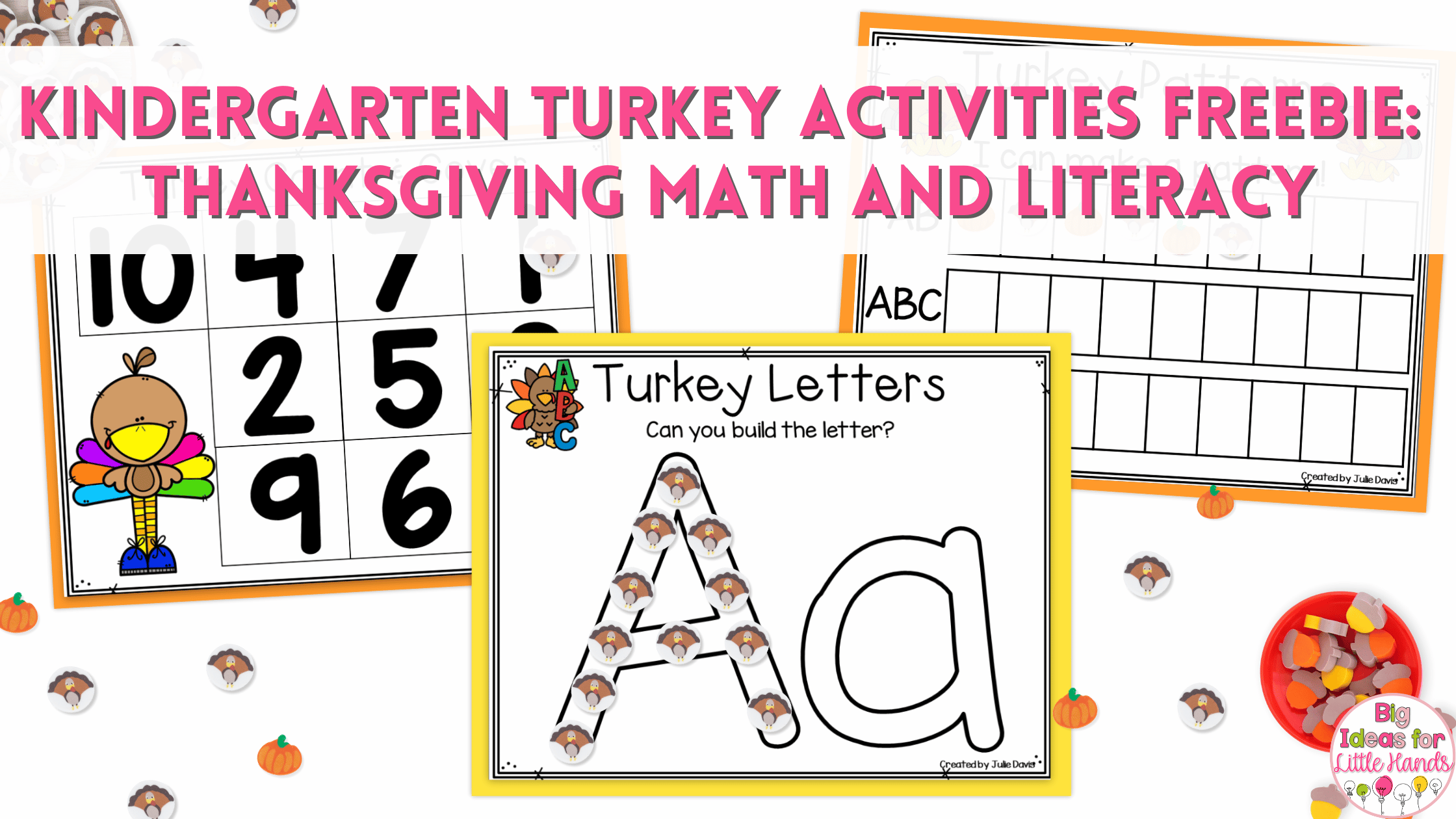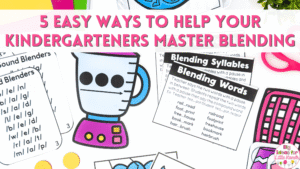Want to turn your students into mini meteorologists, but not sure where to start? Weather lapbook activities are an amazing way to engage your students in a study of different types of weather while also saving you time and classroom space!

You realize that your next themed study is weather. . . So, you head to Google and type in weather activities. You get a million results. Sound about right? All of those individual activities can easily be used in your classroom with much less hassle. How? By using Weather Lapbook Activities!
Using Lapbooks in Your Classroom
Lapbooks are a great way to tackle themed studies in your preschool or primary classroom. The idea behind lapbooks is that they act as mini interactive notebooks for your students.
You can easily complete and contain a multitude of activities in a lapbook. No more reason to have bin upon bin of themed materials. Your students will have everything they need in one neat file folder. Plus, at the end of your unit, they have a keepsake to bring home and share with their families to show off what they have learned!
Getting Weather Lapbook Activities Started
The good thing is that using lapbooks isn’t complicated! I bet you already have all of the materials you need right in your classroom. To get these weather lapbook activities started, all you will need are:
- Manila file folders
- Scissors
- Glue
- Colored pencils, markers, or crayons
- Printouts for each activity, OR the Weather Lapbook resource
- Cotton balls (if you choose to do the cloud activity)
Once you have gathered all of the materials, you are ready to go! Want to learn more about how to set up your lapbooks? Check out this blog post. Getting started is as easy as 1-2-3!

All About The Weather Flipbook
I love using an All About the Weather Flipbook activity to help introduce my students to the weather theme. I start by telling them that they will become meteorologists and learn about different types of weather so that they can tell others about it! Setting up our weather study this way gets students excited to share what they have learned with others. Hopefully, parents are ready for in-depth daily weather reports!
Then we take some time and talk about different types of weather they have seen and what the weather is like out on that particular day. For each type of weather, we come up with a list of adjectives we can use to describe it. For example, for sunny, students might say: warm, bright, yellow.
With the adjectives posted on anchor charts on the board, students head back to their desks and start on their All About the Weather Flipbooks.
For some students, I put the books together ahead of time in their lapbooks, and for other groups of students, they follow my step-by-step directions to glue the flipbook into their lapbook. Use your judgment when it comes to the students in your class and what would work best!
For each type of weather, students draw what that type of weather looks like and then use the adjectives we brainstormed to write a description of it.
In my Weather Lapbook resource, the flipbook includes sunny, rainy, snowy, cloudy, and stormy. You could always include other types of weather as well, based on your location, student interest, etc. This flipbook works as a reference for the rest of our unit.
Draw the Weekly Weather
Once students have identified and described different types of weather, I love to work more on their observation skills and really lean into the idea that they are meteorologists! That’s where this Draw the Weekly Weather lapbook activity comes in.
I have students create an accordion-style pull-out in their lapbooks that has a spot for each day of the week (Monday-Friday).
On Monday, we begin the activity together by going to the windows and describing what we see. I usually ask one or two students to give me the “weather report” just like a meteorologist would. Then, students sit at the window and draw the weather for the day.
This process continues throughout the week until they have filled the whole pull-out with weather images. If you wait for a week that has varied weather, students will love comparing one day to the next!
To have even more fun, students can compare their drawings with others and discuss similarities and differences. It is great for them to see that even though they are looking at the same type of weather, everyone has different perspectives!
I Can Make a Cloud

This is my favorite weather lapbook activity, and my students too! For this activity, you will need some cotton balls.
These will become different types of clouds in your students’ lapbooks. We start by looking at pictures of different types of clouds.
I really like using actual photos versus clipart or cartoon images since we are focused on being meteorologists, and meteorologists would study actual clouds.
I ask students how the pictures look similar or different. If your students are having a hard time describing similarities and differences, I highly suggest modeling for them by comparing two of the cloud images.
Use very specific language to describe each cloud and circle or point to the differences and similarities. This should hopefully set up your students for success in the rest of the discussion.
Once we have established that there are different types of clouds. I introduce 4 cloud types: cirrus, cumulus, stratus, and cumulonimbus. I show students several images of each type and ask them to describe each one based on the images.

Finally, we make our clouds! Students get out their weather lapbooks and glue in the interactive flaps for the different types of clouds. Then, I hand out cotton balls and they get to work. Students manipulate the cotton balls by pulling, stretching, ripping, etc., to create a visual representation for each of the 4 types of clouds. Finally, they glue them down in their lapbooks and leave them open to dry.
Once they are done, we don’t stop there! Students set their lapbooks out on their tables so that the class can go around and see everyone’s creations. To take this activity a step further, you could even ask students to compare and contrast their creations with a friend.
Bonus Weather Activity: Weather Tools
I couldn’t finish this post without sharing an extra activity that will help your students grow their vocabulary and make them really feel like meteorologists!
Students are given a printout with the name and pictures of 6 common weather tools: barometer, rain gauge, weather vane, windsock, weather balloon, and thermometer. They cut out the cards and place them in the pouch we created for their lapbooks.
Each day, I introduce a new weather tool. Students pull out the cards and set them on their desks as we start the activity. I bring in a real-life example of the tool, if possible, and show them how it works. Students get a chance to see it up close, and we bring it outside to test it out.
Then we use the tool for the rest of the weather study, checking it each day. I show them how to read the tool and record their observations. These observations are fun to report on during our daily weather reports!
I love introducing these weather tools and having the vocabulary cards in their lapbooks for continued review. Some people might shy away from teaching younger students more complex vocabulary, but I have found it to be invaluable. Students rise to the occasion and expand their knowledge when given the opportunity!
More Fun and Engaging Weather Lapbook Activities
The possibilities of lapbooks are endless! Here are a few more of my favorite activities from the Weather Lapbook activities set:
- Weather KWL
- Weather Word/Picture Match
- Clouds can/have/are
- Meteorologists study/use/can
- Describe the Weather
- Weather Facts
- Weather Vocabulary
- My Favorite Type of Weather is…writing prompt
- Weather Tools
- Compare Sunny/Snowy, Rainy/Sunny, Snowy/Rainy
- Favorite Weather Book
- Graph the Weather
Use these weather lapbook activities to immerse your students in a fun and engaging weather study. By the end of your unit, your class will be filled with mini meteorologists for sure!
Digital Weather Lapbooks
Yes, there are even more ways to customize these weather lapbook activities for your students! I know the value of digital activities both in the classroom and for distance learning. That’s exactly why I created Digital Weather Lapbooks, too! You might be wondering how these work. . . Let’s break it down!
Essentially, they contain all of the same weather lapbook activities as the printable version, except in a digital format. This means you can pop them up on a Smart Board for group instruction or assign them to students in Google Classroom. You or your students will drag and drop the answers on each slide to complete the activities.
There are sorting activities, matching games, writing pages, weather facts, and more! There are also fun weather videos included that you can play for your whole class to watch. I’ve done the work for you, so you don’t have to hunt down engaging, age-appropriate weather videos with these activities. I love having the digital version as an option because it’s just another way to learn about weather and practice what we’ve learned in a new way. I tend to use the digital weather lapbook activities as whole-group activities for instruction and review. They also make excellent assignments for distance learning classrooms, and even homework!
Your Ready to Use Weather Lapbook Activities
You can find all of these weather lapbook activities in the Big Ideas for Little Hands store. These resources come in two versions. The printable version has everything you need to create a physical lapbook with your students. The digital version is a great way to incorporate some technology skills while still teaching and working on the same great science standards. Click the images below to check out each version.
Still not sure if these weather lapbook activities will work in your classroom? No worries, I get it! To help you decide if these would be a good fit for your students, grab an exclusive freebie from the printable Weather Lapbook Resource by entering your email below. I’ll send it straight to your inbox so you can try one of the activities from the unit for yourself.
Save These Weather Lapbook Activity Ideas
Make sure to save these weather lapbook activities to your favorite classroom Pinterest board! That way, when you decide to tackle a weather study, you will have everything you need.




